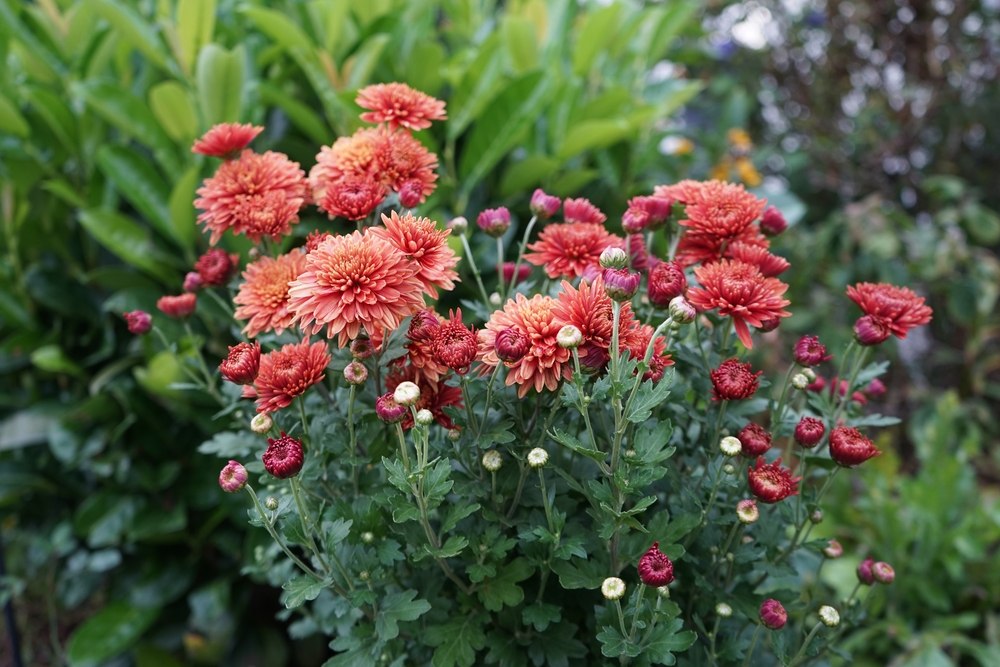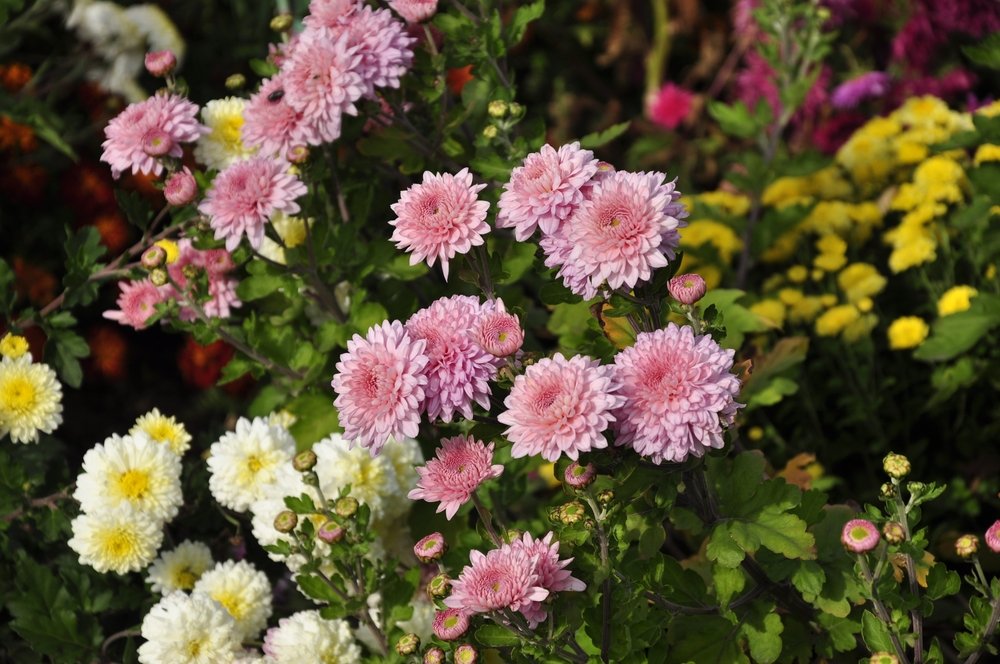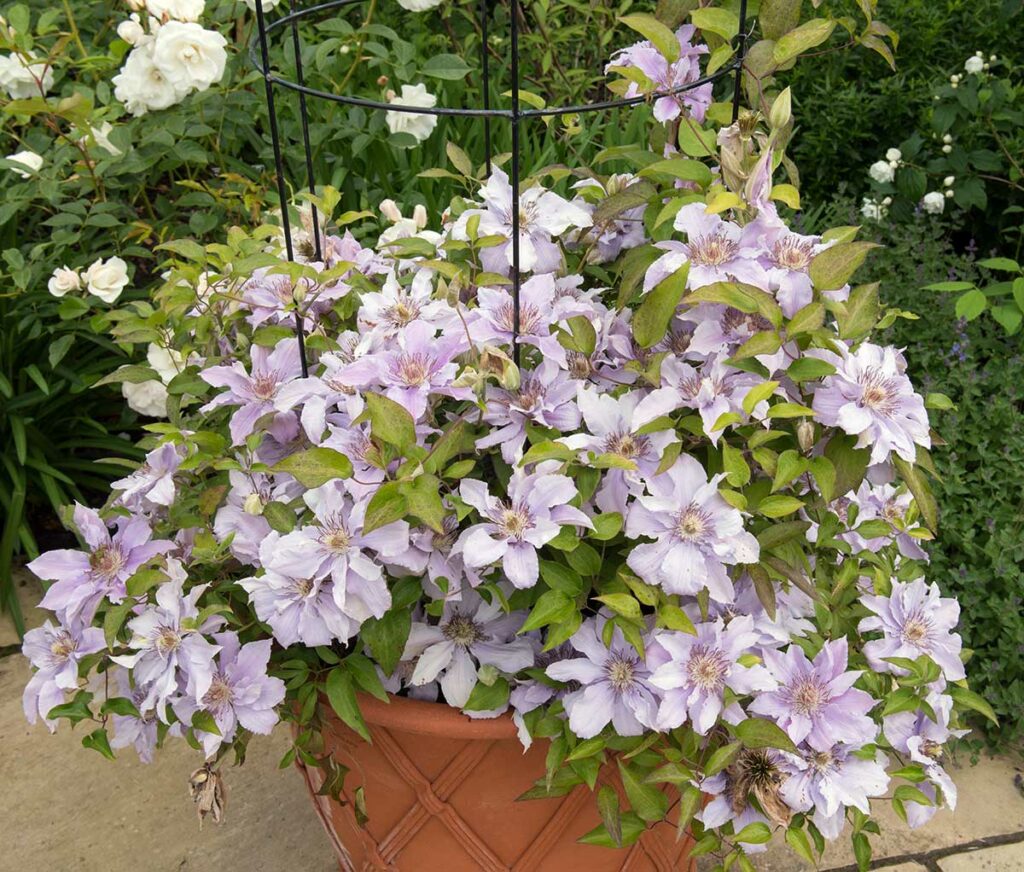
As the fall season approaches, you may be considering which plants to add to your garden.
Chrysanthemums, commonly known as mums, are an excellent choice for many reasons. These vibrant and versatile flowers not only bring a burst of color to your outdoor space, but they also offer numerous benefits that make them an ideal addition to any garden.
Chrysanthemums come in a wide range of colors, shapes, and sizes, allowing you to create various aesthetics to suit your preference.
With their long-lasting blooms and low-maintenance nature, these flowers will provide a beautiful display throughout the fall.
Keep reading to discover five compelling reasons why you should plant chrysanthemums in your garden this season.
Beautiful Bloomers: 5 Reasons to Plant Chrysanthemums this Fall

1. Boost your garden’s aesthetics with vibrant colors
Chrysanthemums, also known as mums, come in a variety of striking colors that can brighten up your garden during the cooler months. You get to choose from shades like yellow, red, bronze, orange, and purple. These blossoming beauties add the perfect pop of color as your summer plants fade away.
2. Easy to grow and maintain
You’ll find growing chrysanthemums to be a breeze, as they are hardy and generally low-maintenance plants. Plant them in well-draining soil, provide enough sunlight, and water them consistently. With minimal effort, you’ll have stunning blooms that can last for weeks.
3. Attract beneficial pollinators
Chrysanthemums not only contribute aesthetically but also play a vital role in attracting beneficial pollinators like bees and butterflies to your garden. These pollinators help promote a healthy and diverse ecosystem in your green space.
4. Versatile and adaptable
Chrysanthemums can be planted in various settings, from garden beds to containers, making them an incredibly versatile addition to your garden, patio, or balcony. Their adaptability can easily accommodate your specific gardening needs and preferences.
5. Symbolize joy and longevity
In many cultures, chrysanthemums represent joy, happiness, and long life. Planting them in your garden can serve as a heartwarming reminder of these positive qualities and bring a sense of warmth and positivity to your autumn days.
By adding chrysanthemums to your garden this fall, you’ll not only enjoy their attractive blooms but also reap multiple benefits such as attracting pollinators, easy maintenance, and adaptability.
Deep Dive into Chrysanthemum Basics

In this section, we’ll explore the world of chrysanthemums, uncovering the essential information to help you cultivate these delightful blooms. We’ll cover chrysanthemum types and discuss the ideal growing conditions for these plants.
Chrysanthemum Types
Chrysanthemums come in a variety of shapes, sizes, and colors, which can imbue your garden with vibrancy. Here are a few popular types to consider planting:
- Pompon: This type features small, round flowers with petals that create a tightly-packed, globe-like appearance.
- Anemone (also known as Daisy): Anemones showcase a central disk surrounded by a ring of long, smooth petals, creating a classic daisy-like appearance.
- Spider Mums: These distinct flowers have long, slender petals that splay outwards like spider legs, making for a unique and eye-catching addition to your garden.
- Quill Mums: Named for their quill-like petals, these chrysanthemums are perfect if you prefer a more delicate look.
Surround yourself with these and many other chrysanthemum varieties to bring color and variety to your garden.
Ideal Growing Conditions
To make the most of your chrysanthemum planting experience, pay close attention to the following elements:
- Light: Chrysanthemums flourish in full sunlight. Make sure they receive at least six hours of direct light per day.
- Soil: Plant your chrysanthemums in well-draining soil with a slightly acidic pH, ideally between 6.0 and 7.0. Avoid soil that is too clayey or waterlogged, as this may lead to root problems.
- Water: Consistent watering is crucial for chrysanthemums, particularly during dry spells. Aim for about one inch of water per week, ensuring that the soil remains consistently moist but not overly saturated.
- Temperature: Chrysanthemums thrive in temperate climates with mild falls. Avoid exposing them to extreme heat or cold, as this can cause stress and inhibit growth.
By providing the right blend of light, soil, water, and temperature conditions, your chrysanthemums are sure to flourish, enhancing the beauty of your garden throughout the fall season.
Reason 1: Versatile and Vibrant Colours

Chrysanthemums offer a fantastic array of colours to brighten your garden this fall. Their versatile and vibrant hues can easily elevate your garden’s aesthetic and complement your existing design. As you add chrysanthemums to your fall planting list, you can expect a beautiful colour explosion.
You’ll find chrysanthemums in shades of red, yellow, orange, white, pink, purple, and even bicolors. This extensive palette provides you with endless possibilities to create stunning floral arrangements or garden edges. Feel free to mix and match different colours to create a unique and eye-catching display.
Additionally, chrysanthemums are well-known for their longevity when it comes to blooming. Most varieties will bloom throughout the fall, ensuring your garden remains colorful even as other plants start to fade. Your chrysanthemums will serve as a reliable source of cheerful tones to keep your garden looking fresh and lively.
Adding chrysanthemums to your fall garden not only guarantees aesthetic improvement but also pays homage to their long-lasting cultural and symbolic significance. In many cultures, chrysanthemums symbolize joy, optimism, and good fortune. With their friendly character, these flowers will warmly welcome you and your guests throughout the season.
Reason 2: Easy to Grow and Maintain

Chrysanthemums are perfect for beginners and expert gardeners alike because they are easy to grow and maintain. All they need is well-draining soil, a sunny spot, and some basic care.
Firstly, plant your chrysanthemums in a location that gets at least 5 hours of direct sunlight daily. This will help them flourish and produce more vibrant blooms. They can tolerate partial shade, but their flowering may be reduced.
Watering chrysanthemums is straightforward; ensure the soil is moist but not waterlogged. Over-watering can lead to root rot and other fungal issues. Keep an eye on the weather, and if you’re experiencing a dry spell, give your chrysanthemums some extra water.
Chrysanthemums aren’t picky about soil, but good drainage is essential. You can improve the drainage by adding compost or organic matter to the planting area. This not only boosts drainage but also enriches the soil, providing essential nutrients for your plants to thrive.
A bit of regular grooming goes a long way. Pinching back the stems will promote bushier growth and more abundant blooms. Pinch back the tips of your chrysanthemums when they reach about 6 inches tall, removing the growth just above a leaf node. Deadheading spent flowers will also encourage continuous blooming throughout the season.
Feeding your chrysanthemums with a balanced slow-release fertilizer will keep them healthy and blooming. Apply the fertilizer according to the manufacturer’s recommendations, typically every 4-6 weeks during the growing season.
One of the best things about chrysanthemums is that they are relatively pest and disease-resistant. While they can occasionally be affected by common garden pests like aphids or spider mites, these issues are easily managed with organic or chemical solutions.
So all it takes is a sunny spot, well-draining soil, and some basic care for your chrysanthemums to thrive this fall, making them an excellent choice for any gardener.
Reason 3: Improve Indoor Air Quality

Chrysanthemums, also known as mums, have more to offer than just their vibrant colors. One of the fantastic benefits of having chrysanthemums in your home is their ability to improve indoor air quality.
According to NASA’s Clean Air Study, chrysanthemums are one of the best air-purifying plants, as they can help remove common toxins like formaldehyde, ammonia, and benzene from the air. These harmful substances often come from everyday household products like paint, cleaning supplies, and even furniture. By simply having chrysanthemums around your living space, you’re creating a healthier environment for yourself and your family.
Another plus point of planting chrysanthemums this fall is their easy maintenance. They require minimal attention, making them an excellent choice for indoor plants. Make sure to place them near well-lit windows, and water them regularly to keep the soil moist. With proper care, you’ll witness stunning blooms while reaping the benefits of cleaner air.
So, don’t hesitate to plant chrysanthemums this fall, as they not only add a splash of color to your home but also contribute to your wellbeing by purifying the air you breathe. Your lungs will thank you!
Reason 4: Pest Repellent Properties

Chrysanthemums are not only known for their stunning blooms, but they also possess natural pest repellent properties. By planting them in your garden this fall, you can enjoy a more vibrant landscape while keeping unwanted guests at bay.
One of the main reasons chrysanthemums are effective pest repellents is due to a chemical called pyrethrum, found in their petals. This natural substance has been used for centuries as an insecticide to combat various pests such as aphids, spider mites, and even ticks. When you plant chrysanthemums in your garden, the pyrethrum can help deter these pests and keep your other plants healthy and thriving.
In addition to repelling insects, chrysanthemums can also help manage nematodes in your soil. Nematodes are microscopic worms that can damage plant roots, impairing their ability to take up nutrients and water. Planting chrysanthemums near susceptible plants, such as tomatoes or potatoes, can reduce the occurrence of nematode-induced damage. Over time, their roots release substances that deter nematodes, making your garden a less hospitable environment for these harmful organisms.
Keep in mind that the pest repellent properties of chrysanthemums are most effective when they are planted strategically around your garden. For example, if you have a vegetable patch or flower bed that is particularly susceptible to pests, planting chrysanthemums nearby may provide better protection. Additionally, you might consider interplanting chrysanthemums with other plants to maximize their benefits and create a diverse, pest-resistant garden.
In summary, planting chrysanthemums this fall can provide your garden with a natural line of defense against pests, while adding beauty to your landscape. By doing so, you’re not only helping your other plants flourish, but also supporting a healthier and more sustainable gardening environment.
Reason 5: Symbolism and Cultural Significance

Chrysanthemums hold deep symbolism and cultural significance in many parts of the world. When you plant these flowers in your garden, not only will they beautify your outdoor space but also bring a sense of history and tradition.
In ancient China, chrysanthemums were considered a symbol of nobility and perfection, valued for their simplicity and elegance. Later, they became associated with autumn and the spirit of harvest. Planting chrysanthemums in your garden will give you a connection to this rich cultural heritage.
In Japan, the flower has an even stronger cultural presence. Called “Kiku” in Japanese, chrysanthemums have long been revered and are even featured on the Japanese Imperial family’s crest. When you grow these flowers, you’ll be part of a beloved tradition that dates back centuries.
Additionally, chrysanthemums are often associated with positive feelings and emotions. They symbolize happiness, longevity, and resilience. Planting them can serve as a powerful reminder to maintain a hopeful and optimistic outlook, even when faced with challenges.
In many Western cultures, chrysanthemums are often given as gifts to symbolize friendship, love, and support. By adding them to your garden, you’ll have a daily reminder of the bonds you share with your friends and loved ones.
So, go ahead and plant chrysanthemums this fall. Not only will they provide a colorful display and many practical benefits, but they’ll also infuse your garden with the rich symbolism and cultural significance that these flowers have carried for centuries.
Conclusion: Chrysanthemums, A Gardener’s Best Friend

Chrysanthemums are versatile plants, which add beauty, vibrant colors, and fragrance to your garden. By planting them in the fall, you can enjoy a fresh burst of color just as the rest of your garden begins to fade with the approaching colder weather.
Not only do these stunning flowers serve as a focal point in your garden, but they also have been known to provide a variety of health benefits. For instance, chrysanthemums have been used to purify the air and aid in respiratory issues. As you enjoy your garden, take a moment to appreciate the air-purifying qualities of your chrysanthemums.
Remember, chrysanthemums are also a gardener’s friend when it comes to attracting pollinators like bees, butterflies, and hoverflies. These beneficial insects will help to maintain a balanced ecosystem while also supporting a successful and thriving garden.
Lastly, don’t forget that chrysanthemums are relatively low-maintenance and can be easily propagated for future planting. So, you can share these cheerful flowers with friends, family, and neighbors.
In conclusion, planting chrysanthemums this fall will not only bring a lovely burst of color and fragrance to your garden, but they will also improve the health of your garden and provide potential gifts for your loved ones. Embrace these beautiful flowers and make them a staple in your fall gardening.













